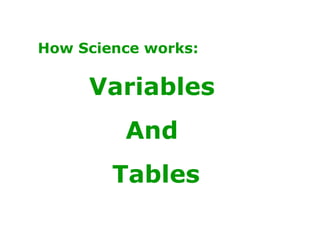
Variables and Tables
- 1. How Science works: Variables And Tables
- 3. Variables Variables are things that vary and change
- 5. Independent (input) variable This is the thing that you decide to change. Example 1 You decide the weight to apply, so: Weight is the in dependent variable. Investigating how a weight affects the length of an elastic band.
- 6. Independent (input) variable This is the thing that you decide to change. You decide the initial temperature, so: initial temperature is the in dependent variable. Example 2 Investigating how the rate of cooling of a beaker depends on the initial temperature.
- 7. Independent (input) variable This is the thing that you decide to change. Which is the independent variable as you add cells? The voltage is the in dependent variable. Example 3 Investigating how the current through a resistor depends on the voltage across it.
- 8. Dependent (outcome) variable This is the variable that changes as a result. It is the variable that you measure. Example 1 You measure the resulting length of the elastic band, so: Length is the dependent variable. Investigating how a weight affects the length of an elastic band.
- 9. Dependent (outcome) variable This is the variable that changes as a result. It is the variable that you measure. You measure the temperature every minute as it cools, so: temperature is the dependent variable. Example 2 Investigating how the rate of cooling of a beaker depends on the initial temperature.
- 10. Dependent (outcome) variable This is the variable that changes as a result. It is the variable that you measure. Which is the dependent variable here? The current is the dependent variable. Example 3 Investigating how the current through a resistor depends on the voltage across it.
- 11. Control variables These are all the variables that must not change, to make sure it is a fair test. Example 1 You must use the same elastic band all the time, and the same scale etc, so it is a fair test. Investigating how a weight affects the length of an elastic band.
- 12. Control variables These are all the variables that must not change, to make sure it is a fair test. Example 2 You must use the same beaker, with the same amount of water, in the same position in the room, at the same room temperature, so it is a fair test. Investigating how the rate of cooling of a beaker depends on the initial temperature.
- 13. These are all the variables that must not change, to make sure it is a fair test. Which are the control variables here? Use the same circuit at the same temperature each time. Example 3 Investigating how the current through a resistor depends on the voltage across it. Control variables
- 14. When you draw up a table of your results, the in dependent variable goes in the first column, like this: Tables If you take several readings of the dependent variable, then you can calculate the mean (average) Then your results will be more reliable .
